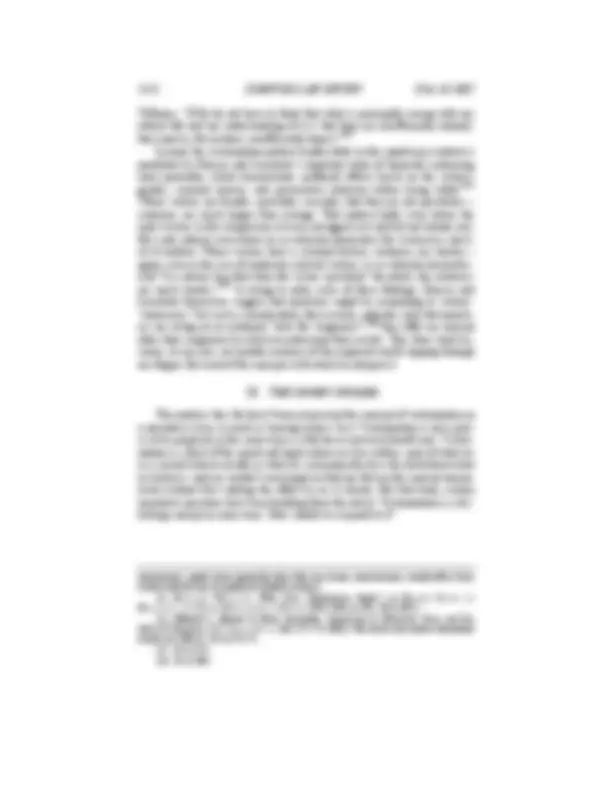




























































Study with the several resources on Docsity

Earn points by helping other students or get them with a premium plan


Prepare for your exams
Study with the several resources on Docsity

Earn points to download
Earn points by helping other students or get them with a premium plan
Community
Ask the community for help and clear up your study doubts
Discover the best universities in your country according to Docsity users
Free resources
Download our free guides on studying techniques, anxiety management strategies, and thesis advice from Docsity tutors
Introduction: the concept of victimization in criminal law and the concept critiqued.
Typology: Study notes
1 / 66

This page cannot be seen from the preview
Don't miss anything!



























































Criminal punishment is systematically harsher, given an otherwise fixed crime, where victims are vulnerable or innocent, and systematically less harsh where victims are powerful or culpable. We make a distinction between one gangster attacking another and a gangster attacking a bystander (though the as- saults might be formally identical) or between selling drugs to an adult and sell- ing them to a child (though the penal code might treat the two as the same). Yet this pattern in blame and punishment has been overlooked. Criminal scholarship and moral philosophy have offered no theory by which to explain it. And, lacking a theory, the pattern itself has been missed or misunderstood empirically. This Article sets forth the concept of “victimization”—the idea that the mor- al status of a wrongful act turns in part on the degree to which the wrong’s victim is vulnerable or innocent and the wrongdoer preys upon that vulnerability or in- nocence. It shows the concept to be implicit in both the doctrine and practice of criminal law. And it argues normatively that victimization is at the same time es- sential to criminal justice and peculiarly prone to illiberal distortions, and should therefore be at once preserved and constrained. A concluding section reflects methodologically on this Article’s approach to moral philosophy in law—an approach in which the law is not just a tool with which to implement the conclusions of an extralegal philosophical inquiry but an object of study with a certain immanent moral content already in place, which philosophy can help bring to light and expose to question.
I NTRODUCTION : THE CONCEPT OF V ICTIMIZATION IN CRIMINAL LAW ................ 1088 I. THE CONCEPT I TSELF ..................................................................................... 1094 A. Describing the Intuition ........................................................................... 1094 B. Some Familiar Explanations That Don’t Work ........................................ 1100 C. A Moral Relationship ............................................................................... 1104 D. Vulnerability and Beneficence, Innocence and Justice ............................ 1109 II. THE CONCEPT AT W ORK ................................................................................ 1113 A. Legal Doctrine ......................................................................................... 1113
1088 STANFORD LAW REVIEW [Vol. 65:
a. In general ..................................................................................... 1116 b. Child sex ...................................................................................... 1119
This Article is about a concept at work in moral culture and criminal law that has not yet been given a name, and so it helps to start with examples. There’s a character in The Wire named Omar Little who is a sort of raider: he robs drug dealers and only drug dealers, and though an aggressive, shotgun- wielding professional criminal, he is nonetheless and however ambiguously a hero in the broken social landscape the show gives us. In a climactic exchange, denounced in the courtroom because of the violent nature of his work, Omar delivers his apologia (“not an apology in our sense of the term... but a de- fense”^1 ). He says: “I ain’t never put my gun on no citizen.”^2 What I would like to understand in this Article is: why does that response make sense? And in particular, that strange yet somehow also obvious use of the word “citizen” for “noncriminal”—why do viewers understand what that term means without ever being told? The scene is effective; what is the moral logic of that effect? Consider now a real case: in Ohio in 1997, Raymond Tibbetts killed his wife and the elderly, invalid man for whom she was a live-in nurse.^3 Both mur- ders were unprovoked and unmitigated; both involved a ferocity of violence— stabbing and beating and the like—that cannot fail to shock and disturb; and both were submitted to the jury for the death penalty. But the jury sentenced
1090 STANFORD LAW REVIEW [Vol. 65:
moral blameworthiness which warrant a judgment of community condemna- tion?”^10
Moore’s assumption—the assumption that victim characteristics don’t fig- ure in the calculus of blame—is typical of the field: mainstream criminal thought has not traditionally looked upon the position of the victim as the sort of thing that needs a theory. What was distinctive about the Moore/Fletcher ex- change was that Fletcher’s challenge brought Moore’s assumption, unmen- tioned throughout the eight hundred pages of his book, to the surface. Usually the assumption stays below the surface, implicit in a silence that extends from high theoretical work like Moore’s to the black-letter doctrine of leading case- books^11 and treatises^12 to the Model Penal Code (MPC).^13 And while, in the wake of the victims’ rights movement, the silence has come increasingly to be noticed and remarked upon,^14 victims’ new prominence has been expressed mainly in the context of criminal procedure, as with victim impact statements. The proposition that most mainstream work has not addressed—and in fact, like Moore, has implicitly rejected—is that victims might be “integrate[d]... into the justification for punishment.” 15 That is “[t]he interesting challenge.”^16 As Cornelius Prittwitz has written, the fundamental idea of victimology and the theoretical center of the victims’ rights movement is that one cannot “look only
May 2013] CRIMINAL VICTIMIZATION 1091
at the offender... in order to understand criminal acts” but must instead view crime as “an interaction” between criminal and victim.^17 The dominant view in criminal law does not look at crime in that way, and indeed lacks the theoretical resources to look at crime in that way.
Yet surely the dominant view is partly true. A victim’s race shouldn’t mat- ter if we are committed to equality, nor his social class, nor his religion. And some characteristics are indeed just irrelevant—whether a victim has blond hair or speaks with a stutter, or some such. But is the dominant view really wholly true, that is, true without exception? Is it really true that it shouldn’t matter whether the victim is a child? That seems mistaken. And what if a state’s crim- inal code says that a victim’s characteristics matter in some way—that murder- ing a child, for example, is an aggravating factor that shifts ordinary intentional murder to some more serious category (as some do 18 )? Are we then to think that no victim characteristic should matter, unless the code says it does, and then it should? That seems confused. In fact, most penal codes contain a variety of provisions—indeed, a vast array^19 —that build victim characteristics into ei- ther the definition of certain crimes (statutory rape, for example), their grading, or both. Those provisions would be incoherent if nothing about the victim could matter. Part of the office of criminal theory is to offer an account, a ra- tionalization in the nonpejorative sense, of why our criminal law is the way it is. Criminal law does respond to victim characteristics in some instances. The dominant view seems incapable of explaining why.
Let’s turn now from law to ordinary moral thought—by which I mean nothing grand or mysterious, but just those everyday intuitions of right and wrong, good and bad, sometimes reflective, sometimes not, that most people make simply in virtue of being evaluative creatures in an evaluative culture. Victims indubitably have a place here. We make a moral distinction between one gangster attacking another and a gangster attacking a bystander, though the assaults might be formally identical, or between selling drugs to an adult and selling them to a child, though the penal code might treat the two as the same (as a matter of fact, some don’t^20 ). We think there is something especially ob- jectionable about financially defrauding the elderly.^21 We think there is some-
May 2013] CRIMINAL VICTIMIZATION 1093
ture—this is moral philosophy as the study of moral culture—and the signal of a good description will be less that the claim comes to seem attractive or bind- ing as that certain resonant cultural patterns light up as the concept on which they’re based comes into view. (Examples from popular culture are thus evi- dence, not color.) Now, admittedly, there’s no purely descriptive way of going about moral philosophy. Even simply identifying a moral idea’s conceptual foundations is justificatory insofar as those foundations prove to be minimally rational. But the chief aim in Part I is to understand rather than to endorse or oppose. It is one thing to identify a moral concept and another to show the moral concept to be at work in the law. Part II takes up that latter goal. The claim here is that the concept of victimization is present in our law —that is, the concept is at work, though almost always implicitly, in the legal doctrine and social prac- tices that make up the criminal system. Victimization is part of the criminal system’s unstated normative logic; it runs through the law like a red thread. Again, this is a descriptive rather than a normative claim; we are still engaged with the first of Durkheim’s two points of view. The issue is not whether we should approve of victimization thinking in criminal law—only that it is there.
Part III turns finally to the second half of Durkheim’s equation: the norma- tive questions. Should we want this concept in our moral lives and criminal law? If equality before the law means anything, it means that the wrongness of killing one person and killing another is the same—right? But then, is it really mistaken to think there is something morally distinctive about, say, killing a child, or tricking someone with Alzheimer’s, or assaulting a blind man? My view is this: victimization is at base a moral insight and properly a component of criminal justice, but it is also peculiarly susceptible to distortion, to being misapplied in operation in ways that offend the basic commitments of a liberal and democratic criminal order. It thus has to be understood and managed rather than simply supported or opposed. Consider, by way of analogy, the principle of loyalty: it too is a deeply rooted and rationally grounded element of ordinary moral thought that is nonetheless dangerous and often misplaced or carried to excess in practice, and it too is something one does not sensibly oppose or en- dorse wholesale but rather chaperones, aware of what is best and worst in it. I view the concept of victimization with the same kind of qualified affirmation. My aim, then, is not simply to defend the concept, but also to make us more self-aware with respect to it. Self-awareness serves justice.
One final note will help forestall confusion. I don’t claim that victimization is the only determinant of a crime’s wrongness (that would be ridiculous), or even the only victim-based determinant of a crime’s wrongness. We have spe- cial punishments for killing the president; those aren’t based on vulnerability or innocence. We also have special punishments for those who harm the agents of the criminal system (police, prosecutors, judges, witnesses, and jurors); those aren’t vulnerability- or innocence-based either. Grading the seriousness of of-
1094 STANFORD LAW REVIEW [Vol. 65:
fenses is a complicated and undertheorized business.^25 I take victimization to be one of the principles that give criminal justice its normative order, one among a number of moral and practical considerations that go toward answer- ing Hart’s great question. It comes into play whenever a crime puts vulnerabil- ity or innocence (or their opposites) particularly at stake. The concept is thus quite specific, but it has, I submit, a general theoretical implication. When Prittwitz argues that we must learn to view crime as “an in- teraction” between criminal and victim,^26 he may be right, but he’s not telling us how to do so. When Fletcher says that integrating victims “into the justifica- tion of punishment” is “the interesting challenge,”^27 he is pointing to a question but not answering it. I don’t think there is at present a fully adequate answer in the literature. Coming to terms with the concept of victimization is a theoretical key that can unlock that door.
A. Describing the Intuition
The first step in explaining the concept of victimization is to bring the intu- ition of victimization more clearly into view—for though the intuition is a fa- miliar part of moral experience, it has not to my knowledge come in for philo- sophical examination before.^28 And it displays some odd dynamics. First—a simple point—the intuition really does seem to respond to the vul- nerability or innocence of victims. It’s spurred when we turn our thoughts to harms or wrongs inflicted upon children, the elderly, the mentally or physically handicapped, or animals, among others. It’s spurred when we think of able- bodied adults attacked while in a position of helplessness, as in a beating, and not spurred (though we might yet disapprove of the wrong) when we think of such people suffering merely in the course of combat or other conflict, as in a fair fight. (When, after all, does a fight become a beating? Could we even make sense of that distinction without something like the concept of victimization?) One of the functions of literature is to teach us to see the contours of moral life
1096 STANFORD LAW REVIEW [Vol. 65:
which something significant has happened? Something significant did happen. That was the moment at which Valjean took the child’s innocence away.
Second, vulnerability and innocence are disjunctive. Hugo’s child vagrant was both vulnerable and innocent—children usually are—but to have both to- gether is not necessary for the victimization intuition to take hold. The elderly and physically handicapped are typically just vulnerable, not innocent (alt- hough senility might change that). If two men get in a fight at a bar, one loses consciousness, and the other continues beating him, the victim is also just vul- nerable, not innocent. By contrast, a fierce animal in an unarmed physical con- frontation is innocent but not vulnerable. The same animal under the control of a person may be both vulnerable and innocent, though not necessarily to the same degree. (As Senator Robert Byrd said during the Michael Vick dog- fighting scandal: “The depravity of dogfighting... involves training innocent, innocent, innocent, vulnerable creatures to kill... .”^36 ) The two pieces of the intuition can be coupled or decoupled, and the intuition may still take hold. Indeed, innocence is internally disjunctive: it has an interior complexity that vulnerability does not. We’ll need some distinctions to puzzle through it. The first distinction is between situational and general innocence. Situational innocence is the state of being blameless with respect to the particular situation in which one is subjected to a wrong—the ordinary adult killed by a stranger while strolling down the street, as opposed to the bank robber killed by his ac- complice for an extra share of the loot. We have a term in our culture for these situationally innocent victims: “innocent bystanders.” (Omar’s term for them was—tellingly, wonderfully—“citizens,”^37 but the usual term has its own ad- vantages, for it is a fixture in our language that would not even be intelligible without the concept of victimization.) General innocence, by contrast, is about moral purity, about being an innocent rather than innocent of something, as with animals and young children, who, lacking full agency, are free of both moral guilt and moral stain. (Logically, general innocence could include a ma- ture, agential moral perfection as well, like a saint. The case rarely arises. But the crucifixion story is an account of a morally perfect victim.) The second distinction internal to innocence is between innocence based on culpability and innocence based on risk-taking. Culpability innocence is a mat- ter of wrongdoing: one has it in virtue of being upright and loses it in virtue of misdeeds. Risk-taking innocence is a matter of responsibility: one has it in vir- tue of prudence and loses it in virtue of recklessness or assumption of risk. It makes a difference to us, for example, whether the person killed in an accident was engaged in extreme sports or was merely unlucky in the course of ordinary
May 2013] CRIMINAL VICTIMIZATION 1097
life, and we care as well whether the person harmed in combat was a soldier who volunteered for the job or a conscript who didn’t. The common thread in all these distinctions internal to innocence is blamelessness, but blame is a ca- pacious concept in our moral culture, and it pulls different kinds of phenomena under the innocence heading. Thus innocence has internally disjunctive pieces that can take hold individually, be variously assembled together, or be various- ly coupled with vulnerability.^38 Third, the victimization intuition is symmetrical—that is, it not only ex- tends an extra measure of concern to wrongs visited upon the vulnerable or in- nocent, but also withdraws a measure of concern from wrongs visited upon the non vulnerable or non innocent—the powerful, risk-taking, or culpable.^39 We are less saddened to hear that a rapist was killed by his victim than to hear that his victim was killed by him. That is not to say we think it good, upon reflec- tion, that the rapist was killed—rape is not a capital crime—but where the judgment is comparative, where there is a quantum of badness that must fall somewhere and the only question is on whom it will fall, we prefer that it fall on a wrongdoer. Again, literature has picked up on this pattern of thought: the figure of the culpable victim is a tremendous fund of dramatic tension. Law & Order: Special Victims Unit , for example, started its immensely successful run with an episode about two rape victims who kill their rapist; the show’s energy comes from the officers’ dilemma over whether to enforce the norm against killing even in that case (they sort of do and sort of don’t).^40 It’s a popular mo- tif. Fourth, the victimization intuition comes in degrees; it’s a spectrum, more- or-less phenomenon, not an either/or. Attacking a child is an extreme case; at- tacking a physically handicapped bystander is a little less extreme; and attack- ing an ordinary bystander, a little less still. This makes good sense because the components of the victimization intuition—vulnerability or innocence on the
May 2013] CRIMINAL VICTIMIZATION 1099
little extra sympathy going to those who were encouraged to make bad invest- ments while lacking the financial education to understand the risks, and a little less sympathy to the big institutional players and wealthy individuals who were similarly misadvised or ripped off. In other words, the victimization intuition is not just reserved for extreme situations but is at work all the time, as if there were a hypothetical median victim to whom every other victim is compared and found to be either more or less vulnerable, innocent, powerful, risk-taking, or culpable. As I see it, the intuition is most interestingly and importantly at work where the situation is extreme—with child victims and gangster victims and so on—but it is not only at work in such cases. It is a general and basic feature of moral life, a regular part of the way in which we go about making judgments of blame and wrong.
As the examples of victimization multiply, one has the sense of the concept working itself through in the social world, opening up logical spaces like slots into which cultural content can flow. There is a slot for the child (vulnerability with general innocence) and another for the innocent bystander (vulnerability with situational innocence); there is a slot for the warrior or hero (situational assumption of risk without culpability or vulnerability) and another for the vil- lain (general culpability and risk-taking without vulnerability); there is a slot for the daredevil (situational recklessness without culpability or vulnerability) and another for the fool (situational recklessness and vulnerability without cul- pability). For every conceptual possibility victimization carves out, the culture, to the extent it has need for it, generates an archetype. The concept is realized in social life.^43
Two final caveats. First, this intuition, being essentially a feature of social life, won’t resonate equally with every individual. Some people may not feel it; many won’t feel it in all respects. But the chief issue is not whether it is present in our feelings but whether it is present in our culture. Second, the intuition, be- ing merely an intuition, may have fuzzy edges not because of a failure to see it clearly but because, as an intuition, it lacks the propositional content to answer all reasonable questions that might be asked of it. That is as it should be. The hard questions have to await a conceptualization of the intuition. Indeed, the process of conceptualization is partly one of trying to find good answers to those questions.
“You’re not the first person to say that.... It was not a smart thing to do.... I wouldn’t say I was nuts, but maybe I thought I was invincible.” Id. The victim later told reporters that she wished she had answered differently: “If that isn’t a blame-the-victim question, I don’t know what is. It’s like, ‘OK, so it’s my fault that I was out there?’” A New Run on Oprah , NEWSDAY, Nov. 16, 2007, at A52 (some internal quotation marks omitted). An exchange like this one is a window into the culture—and it is unintelligible without the concept of victimi- zation.
1100 STANFORD LAW REVIEW [Vol. 65:
B. Some Familiar Explanations That Don’t Work
We turn now from bringing the intuition into view to explaining it—which is surprisingly difficult. It resists many familiar modes of moral explanation.
First, the concern for victimization cannot be explained on the basis of rights. What makes the concept such an astonishing feature of the moral uni- verse is precisely that a person can, in two instances, invade the very same right with the very same intention and yet, in one of those instances, be worse or more blameworthy than in the other. In the language of criminal law, the same actus reus with the same mens rea can be wrong to different degrees based on a characteristic of the victim. That should impress us as a deep puzzle. On some views, a wrong just is the invasion of a right. Some forms of deontology, for example, in picturing human beings essentially as rightsholders, understand wrongdoing essentially as rights-invasion. Victimization on such a view is al- most impossible to make sense of. Could one fit victimization into a rights framework by postulating, say, a “right not to have one’s purity (general innocence) taken away,” or a “right not to be harmed where blameless (situationally innocent) in occasioning the harm,” or a “right not to have one’s vulnerabilities exploited,” or something else of that sort? The problem is that these postulated rights don’t explain vic- timization: they just recast the concept in other language. Furthermore, these claims of right are implausible on their own account: a young and vigorous adult has a right not to be beaten up just as surely as an old and frail one; what- ever significance youth and vigor might have, they do not impair the right to physical security. And finally, even forced, implausible claims of right may not be able to capture the victimization concept in full—for what claim of right could explain reducing the protection afforded risk-takers and wrongdoers? In the end, if we accept that the concept of victimization is minimally rational, we must also accept that two equally purposeful invasions of the same right might not have the same moral status, or even be quite the same moral phenomenon. To steal from a blind person and from a sighted person is not the same thing, though in both cases the right invaded is the right of property. This is also to say, of course, that the framework of rights cannot give a complete picture of moral life.
Second, victimization cannot be explained on the basis of norm violation, at least insofar as norms are thought of (rather thinly) as commands or rules— another common deontological focal point and the main issue in retributivist accounts like Moore’s.^44 The problem is just what we saw a moment ago with respect to rights. If on the one hand we define norms in general terms that make no reference to victim characteristics—“intentionally taking another’s property is wrong,” for example—then victimization is impossible: two violations of the
1102 STANFORD LAW REVIEW [Vol. 65:
harm does indeed account for the greater wrongfulness, but the greater vulnera- bility and innocence accounts for the greater harm—which is to say, we need to build vulnerability and innocence into our understanding of harm itself. In the messy way that moral concepts are lived, it isn’t surprising—and it isn’t a re- buttal—to find this sort of overlap. Fourth, victimization cannot adequately be explained (again a caveat is necessary) on the basis of social cost or deterrence—also common modes of explanation among consequentialists and particularly utilitarians.^47 The prob- lem with explaining victimization in terms of social cost is parallel to the prob- lem of explaining it in terms of suffering or harm (that is, individual cost). First, social cost and victimization can move independently and even in oppos- ing directions: the murder of an elderly person past her productive working years, for example, would ordinarily be thought to involve less social cost than the murder of a middle-aged person with many productive years left—so tort law views them—but the one involves a high degree of victimization and the other, all else equal, a lower one. And second, where social cost and victimiza- tion do move together, the explanation for that judgment turns on victimiza- tion’s two components, vulnerability and innocence, not the other way around. If, for example, we regard the death of the rapist as less costly as a social matter than the death of his victim, the explanation turns on the diminishment of the rapist’s social value on account of his wrong or, in other words, on his cul- pability.
Deterrence at first glance presents a greater challenge. It can explain con- cern for victims’ vulnerability insofar as an extra measure of punishment may be necessary to deter wrongdoing against those who cannot deter it of their own power. And it can explain concern for victims’ innocence insofar as a lesser measure of punishment for those who harm wrongdoers and risk-takers may discourage people from becoming wrongdoers and risk-takers in the first place. I’m not sure if the overlap here is partial or total, but even if total, I don’t think it undermines the need to give an explanation of victimization in the terms in which it is experienced: noninstrumental terms of blame and wrong, desert and virtue. There’s nothing new about moral instrumentalists and non- instrumentalists explaining the same phenomenon in different ways (and wres- tling over whose explanation is better). In fact, the lesson of this overlap is not that the concept of victimization can be done away with, but that the concept has legs. It turns out that deterrence theorists and perhaps other criminal pun- ishment instrumentalists, who have not to my knowledge taken an interest in victims’ vulnerability or innocence before, have reason to do so. That the con- cept speaks to them as well as to those who think of criminal punishment in more natively moral terms (retributivists, virtue theorists, and expressivists, among others) is all to the good.
May 2013] CRIMINAL VICTIMIZATION 1103
Finally, victimization cannot adequately be explained on the basis of sym- pathy or empathy, that is, on the basis of sentiment—the typical focal point in scholarly work that, lacking the concept of victimization, nonetheless brushes up against victimization thinking.^48 I say “adequately” because there is no question that predation upon the vulnerable or innocent elicits passionate feel- ings of sympathy and empathy for the victim and anger or hatred toward the wrongdoer. One could even imagine a good evolutionary case for why we would feel these passions, centering on our reproductive interest in the safety of children. But even if true, that sort of psychological explanation is not a substi- tute for philosophical or normative explanation of the kind this Article at- tempts. We want different things from psychological and normative explana- tion. The one is a matter of motivation; the other is a matter of testing whether our motivations are based on or linked to ideas that we can reflectively endorse. It is not enough to know that the invasion of the bodies of children, sexually or otherwise, fills us with horror and disgust, or even that it fills us with horror and disgust because we have an evolutionary interest in the well-being of chil- dren, because we want the rationale for that horror and disgust; we want to know whether and how it is justified. Furthermore, if the two forms of explana- tion are too independent for the one to take the other’s place, they are also too inter dependent—for our emotions are themselves evaluative in character, sub- ject to correction where those evaluations go awry.^49 We would not want a moral or criminal system that excused the beautiful and condemned the ugly. We want our normative systems to act on principle, and sympathy and empathy alone, taken purely as facts about our passions rather than as elements in moral reason, are too standardless to serve that purpose. Part of the point of philo- sophical inquiry into moral life is to fashion our passions into sound moral guides. But if we do not chalk victimization up to passion and sentiment, what is left to explain it? We have just rejected many of the classic modes of moral ex- planation—explanation in terms of rights or norms or in terms of individual or social suffering, harm, or cost. It may be tempting at this point to think that the concern for victimization cannot be accounted for rationally, but I think that’s a mistake. Moral life is subtler than moral theory. When the two are out of joint, we should not be too quick to think it is moral life that has gone wrong.
May 2013] CRIMINAL VICTIMIZATION 1105
which we fall.”^56 The question is, how do we think about the moral universe when we are exhibiting the virtue of justice?
What Thompson picks out in answer is the relational—or as he puts it, “bi- polar”—aspect of such thought:
The mark of this special virtue of human agents... is that it is ‘toward anoth- er’.... It is characteristic of the individual bearer of justice... to view her- self as related to others, and as other to others... .”^57
That is, whatever the particular content of our thoughts regarding justice, the grammar of the thought is that there is a me and a you linked together in a cer- tain morally charged relationship. As Thompson puts it, there is in the mental posture of justice a “yoking of agent to agent”^58 in a “formally distinctive type of practical nexus.”^59 “[The two agents] are for me,” he says, “like the oppos- ing poles of an electrical apparatus: in filling one of these forms with concrete content, I represent an arc of normative current as passing between the agent- poles, and as taking a certain path.”^60 The concrete content in that arresting im- age can be any particular claim of justice—that agent A owes agent B an apolo- gy, or that B owes A performance on a contract, or that A trespassed on B ’s land or on his freedom or whatever else—but what absorbs Thompson’s focus are not those particularities but the structure in which they fall: the very fact of those two poles and the normative current passing between them. The posture of mind characteristic of justice is that one sees oneself as occupying one of those poles and all others with whom one comes into moral contact as occupy- ing another. Justice, in short, is an other-regarding virtue. In that essential sub- mission, Thompson joins Aristotle, Aquinas, and Kant, among others; it seems to me that this is a point on which much of the philosophical tradition concurs.
From this base, Thompson develops a more refined version of the initial contrast I offered between Eve’s wrong and Cain’s, between wrongdoing as a violation of norms and wrongdoing as a violation of others. In Thompson’s terms, this is a contrast between “bipolar normativity” and “merely monadic normativity,” between a form of moral life in which we say “ X wronged Y by doing A ” and one in which we say only that “ X did wrong in doing A ”— Y hav- ing dropped out of the picture.^61 The former is a three-part relation between agent, victim, and norm, in which the relationship between the agent and victim has somehow become corrupted and the norm serves to describe or account for the way in which it has become corrupted. The latter is a two-part relation be-
1106 STANFORD LAW REVIEW [Vol. 65:
tween agent and norm, in which the person wronged is incidental to the state- ment of the moral issue (though potentially necessary, depending on how the norm is defined, for the norm to have been violated at all). One could wonder what this difference really amounts to. It seems possible to redescribe most or perhaps all bipolar moral claims as merely monadic ones (“Cain did wrong in committing murder” rather than “Cain wronged Abel by murdering him”) and perhaps it would be possible to go the other direction too, redescribing merely monadic claims as bipolar ones (“Eve wronged God by vi- olating his trust” rather than “Eve did wrong in violating God’s law”—though that recasting of the issue seems somehow more strained). One could imagine a partisan of one of these two modes of moral thought trying to colonize the field. So is the difference a real one? Thompson tells us that “tradition and intu- ition alike assign [the merely monadic claims] a place very different from that occupied by our bipolar forms,” 62 and that may be, but is there some more def- inite reason for the distinction than mere fidelity to tradition and intuition? I think there are five such reasons. First and most important, our social practices fall into monadic or bipolar forms already and thus become inaccessi- ble or unintelligible if we don’t have recourse separately to each of these two options. Apology and forgiveness, for example, are bipolar: I cannot forgive a wrong done to you.^63 Private law is bipolar: the claim for breach belongs to the promisee, for tort to the injured. These practices are part of the architecture of social life, yet a merely monadic view of morality would be baffled by them. Second (and relatedly), whether we take a monadic or bipolar view of some type of wrongdoing will affect our redressive scheme because the distinction bears on whether the claim for redress belongs to the community or to the vic- tim. A monadic understanding of promise breaking, for example, would sug- gest that anyone might take action to rectify the breach—the issue being that A broke a promise, rather than that A broke a promise to B —whereas a bipolar understanding would suggest that the demand for redress belongs to the promi- see alone. This question of redressive form is of course a major issue in the law. Third, the possibility of redescribing bipolar claims as monadic ones and vice versa does not undermine the distinctiveness of the two forms. What makes them distinct is not just how the claim is described or expressed, but whether, in accounting for, say, Cain’s wrong, we would need finally to say something about Abel (about his dignity, for example, or his value), or in ac- counting for Eve’s wrong, we would need finally to say something about God (about his divinity, for example, or his authority as moral lawgiver). The issue is what object of moral consideration is explanatorily basic. Fourth, monadic